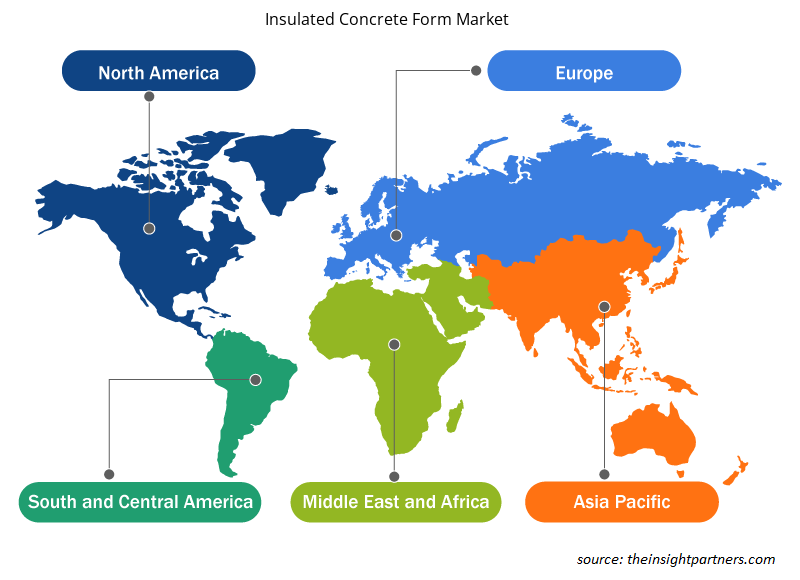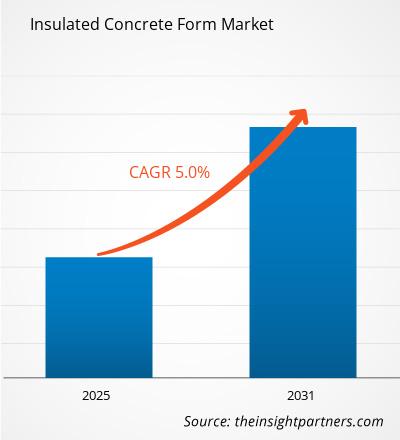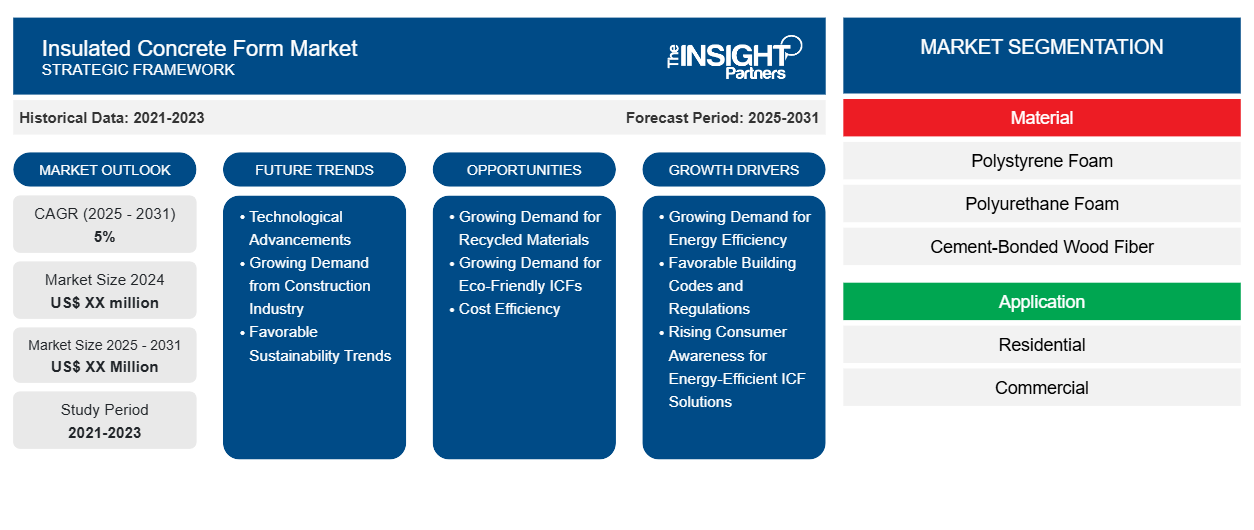预计绝缘混凝土模板市场在 2023 年至 2031 年期间的复合年增长率为 5%,市场规模将从 2023 年的 XX 百万美元扩大到 2031 年的 XX 百万美元。
报告基于材料(聚苯乙烯泡沫塑料、聚氨酯泡沫塑料、水泥粘合木纤维等)进行分析。报告按应用(住宅、商业和其他)进行细分。全球分析进一步细分为区域和主要国家。范围涵盖所有关键细分市场的全球、区域和国家层面的市场规模和预测。报告以美元为单位提供上述分析和细分市场的价值。报告提供了主要市场参与者的市场状况的关键统计数据,并提供了市场趋势和机会。
报告目的
Insight Partners 发布的《绝缘混凝土模板市场》报告旨在描述当前形势和未来增长、主要驱动因素、挑战和机遇。这将为各种业务利益相关者提供见解,例如:
- 技术提供商/制造商:了解不断变化的市场动态并了解潜在的增长机会,从而能够做出明智的战略决策。
- 投资者:对市场增长率、市场财务预测以及整个价值链中存在的机会进行全面的趋势分析。
- 监管机构:监管市场政策和警察活动,旨在最大限度地减少滥用行为,维护投资者的信任和信心,维护市场的完整性和稳定性。
绝缘混凝土模板市场细分
材料
- 聚苯乙烯泡沫
- 聚氨酯泡沫
- 水泥粘合木纤维
应用
- 住宅
- 商业的
定制此报告以满足您的需求
您可以免费定制任何报告,包括本报告的部分内容、国家级分析、Excel 数据包,以及为初创企业和大学提供优惠和折扣
- 获取此报告的关键市场趋势。这个免费样品将包括数据分析,从市场趋势到估计和预测。
绝缘混凝土模板市场的增长动力
- 能源效率需求不断增长:建筑设计中对能源效率的高度重视是 ICF 市场增长的主要推动因素之一。随着可持续建筑成为政府和组织的优先事项,ICF 成为降低能源消耗的有效工具。由于具有出色的隔热性能,它们需要更少的加热和冷却,因此 ICF 成为具有环保意识的建筑商的有吸引力的选择。
- 有利的建筑规范和法规:除此之外,严格的建筑规范和法规强制使用节能材料,如 ICF。这些类型不仅可以提高性能,还可以确保此类建筑达到绿色建筑的地位。因此,建筑师和承包商将 ICF 纳入他们的计划中,以满足规范和整体可持续环境。
- 消费者对节能 ICF 解决方案的认识不断提高:此外,消费者对节能的认识不断提高,这也推动了可持续建筑解决方案对节能的需求。这让家庭和企业渴望拥有能够最大限度降低能源成本和对环境有害影响的建筑。在这里,ICF 拥有极好的机会将弹性与节能特性相结合;无论是在住宅还是商业建筑领域,它都被认为是最佳选择。
绝缘混凝土模板市场未来趋势
- 技术进步:技术进步对 ICF 行业的发展产生了重大影响。它不断推动创新并提高产品性能,而新材料和制造技术则增强了 ICF 的隔热能力以及结构完整性。此类 ICF 将是建筑商和建筑师在施工时的首选。
- 建筑行业需求不断增长:此外,设计软件变得更加复杂,并改善了 ICF 结构的规划和实施。建筑信息模型可以更好地将 ICF 可视化并集成到不同的建筑设计中,从而简化施工流程。它最大限度地减少了错误并改善了利益相关者之间的协作。
- 有利的可持续发展趋势:ICF 市场在涉及智能材料的新发展方面势头强劲,这些材料旨在随着环境条件的变化而变化。这些材料可以优化能源性能,再次朝着更可持续的目标迈进,以响应建筑绿色化的趋势。为了跟上这种方法,ICF 不会落后于及时迎接挑战。
绝缘混凝土模板市场机会
- 对再生材料的需求不断增长:ICF 再生材料的生产为市场带来了显著增长。鉴于建筑行业对可持续性的关注,制造商正在使用更多再生成分,例如塑料和混凝土骨料,以减少对环境的影响。这进一步符合对环保建筑材料日益增长的需求。
- 对环保型 ICF 的需求不断增长:通过使用再生材料,ICF 可减少碳足迹,同时还有助于废物处理。再生材料的整合使制造商能够接触到有意识和环保意识的建筑运营商,他们寻求环保选择。这将提高市场竞争力,并通过吸引有环保意识的客户来确保品牌忠诚度。
- 成本效益:重复使用材料将降低生产成本。从废物流中获得的原材料成本将保持在较低水平,同时保持质量和性能标准。这种经济优势对建筑公司来说确实很有吸引力,因为他们可以在不影响建筑标准的情况下削减预算。
绝缘混凝土模板市场区域洞察
Insight Partners 的分析师已详细解释了预测期内影响绝缘混凝土模板市场的区域趋势和因素。本节还讨论了北美、欧洲、亚太地区、中东和非洲以及南美和中美洲的绝缘混凝土模板市场细分和地理位置。

- 获取绝缘混凝土模板市场的区域特定数据
绝缘混凝土模板市场报告范围
| 报告属性 | 细节 |
|---|---|
| 2023 年的市场规模 | XX 百万美元 |
| 2031 年市场规模 | XX 百万美元 |
| 全球复合年增长率(2023 - 2031) | 5% |
| 史料 | 2021-2022 |
| 预测期 | 2024-2031 |
| 涵盖的领域 | 按材质
|
| 覆盖地区和国家 | 北美
|
| 市场领导者和主要公司简介 |
|
绝缘混凝土模板市场参与者密度:了解其对业务动态的影响
绝缘混凝土模板市场正在快速增长,这得益于最终用户需求的不断增长,这些需求源于消费者偏好的不断变化、技术进步以及对产品优势的认识不断提高等因素。随着需求的增加,企业正在扩大其产品范围,进行创新以满足消费者的需求,并利用新兴趋势,从而进一步推动市场增长。
市场参与者密度是指在特定市场或行业内运营的企业或公司的分布情况。它表明在给定市场空间中,相对于其规模或总市场价值,有多少竞争对手(市场参与者)存在。
在绝缘混凝土模板市场运营的主要公司有:
- RPM国际公司
- Amvic 公司
- Logix 品牌有限公司
- Airlite Plastics Company 和 Fox Blocks
- BuildBlock 建筑系统有限责任公司
- 巴斯夫 Neopor
免责声明:上面列出的公司没有按照任何特定顺序排列。

- 获取绝缘混凝土模板市场顶级关键参与者概述
主要卖点
- 全面覆盖:报告全面涵盖了绝缘混凝土模板市场的产品、服务、类型和最终用户的分析,提供了整体概况。
- 专家分析:报告基于对行业专家和分析师的深入了解而编写。
- 最新信息:该报告涵盖了最新信息和数据趋势,确保了其与业务的相关性。
- 定制选项:此报告可以定制以满足特定客户要求并恰当地适应业务策略。
因此,绝缘混凝土模板市场研究报告有助于引领解读和了解行业情景和增长前景。尽管可能存在一些合理的担忧,但本报告的总体优势往往大于劣势。
- 历史分析(2 年)、基准年、预测(7 年)及复合年增长率
- PEST和SWOT分析
- 市场规模、价值/数量 - 全球、区域、国家
- 行业和竞争格局
- Excel 数据集
近期报告
客户评价
购买理由
- 明智的决策
- 了解市场动态
- 竞争分析
- 客户洞察
- 市场预测
- 风险规避
- 战略规划
- 投资论证
- 识别新兴市场
- 优化营销策略
- 提升运营效率
- 顺应监管趋势





















 获取免费样品 - 绝缘混凝土模板市场
获取免费样品 - 绝缘混凝土模板市场